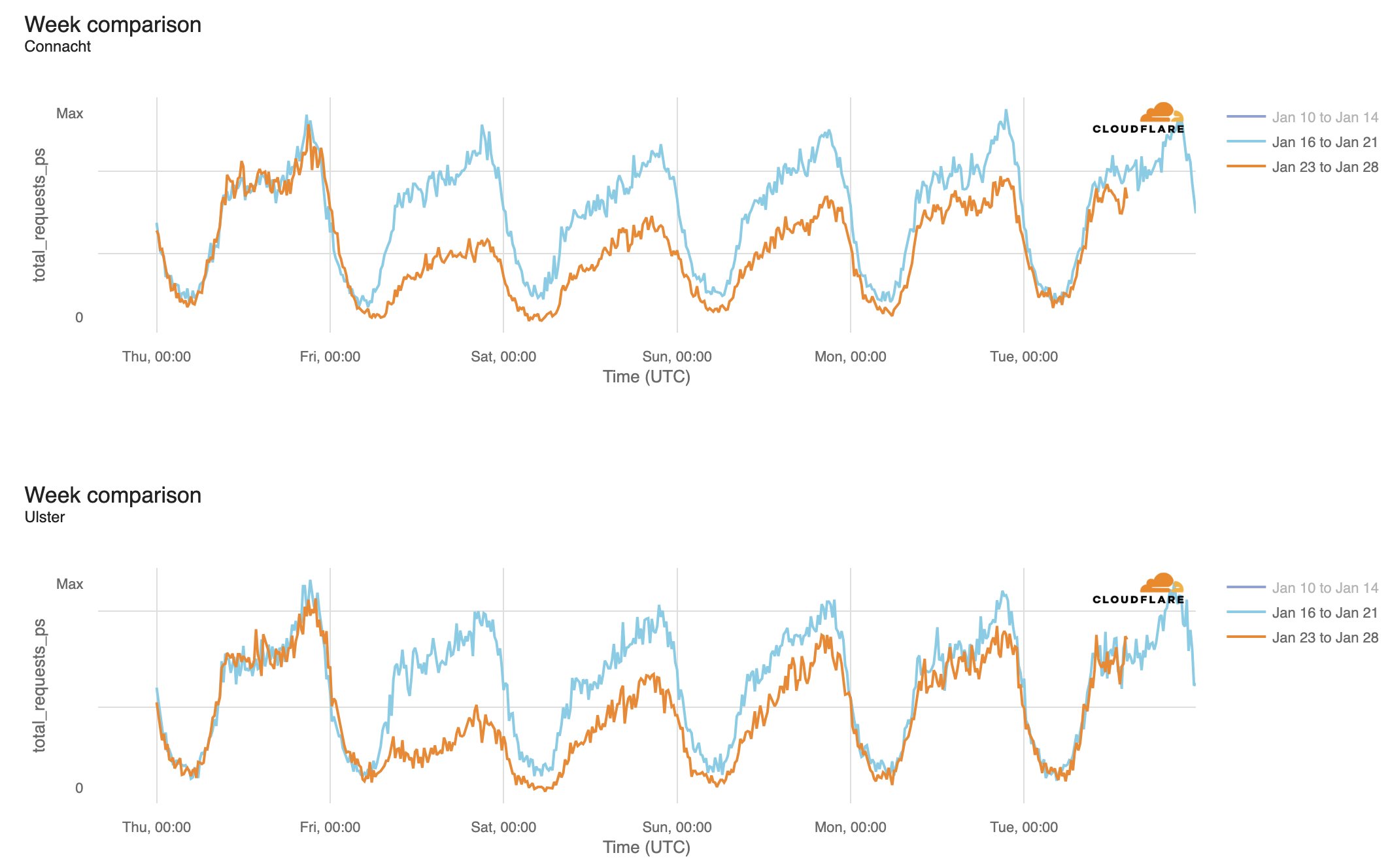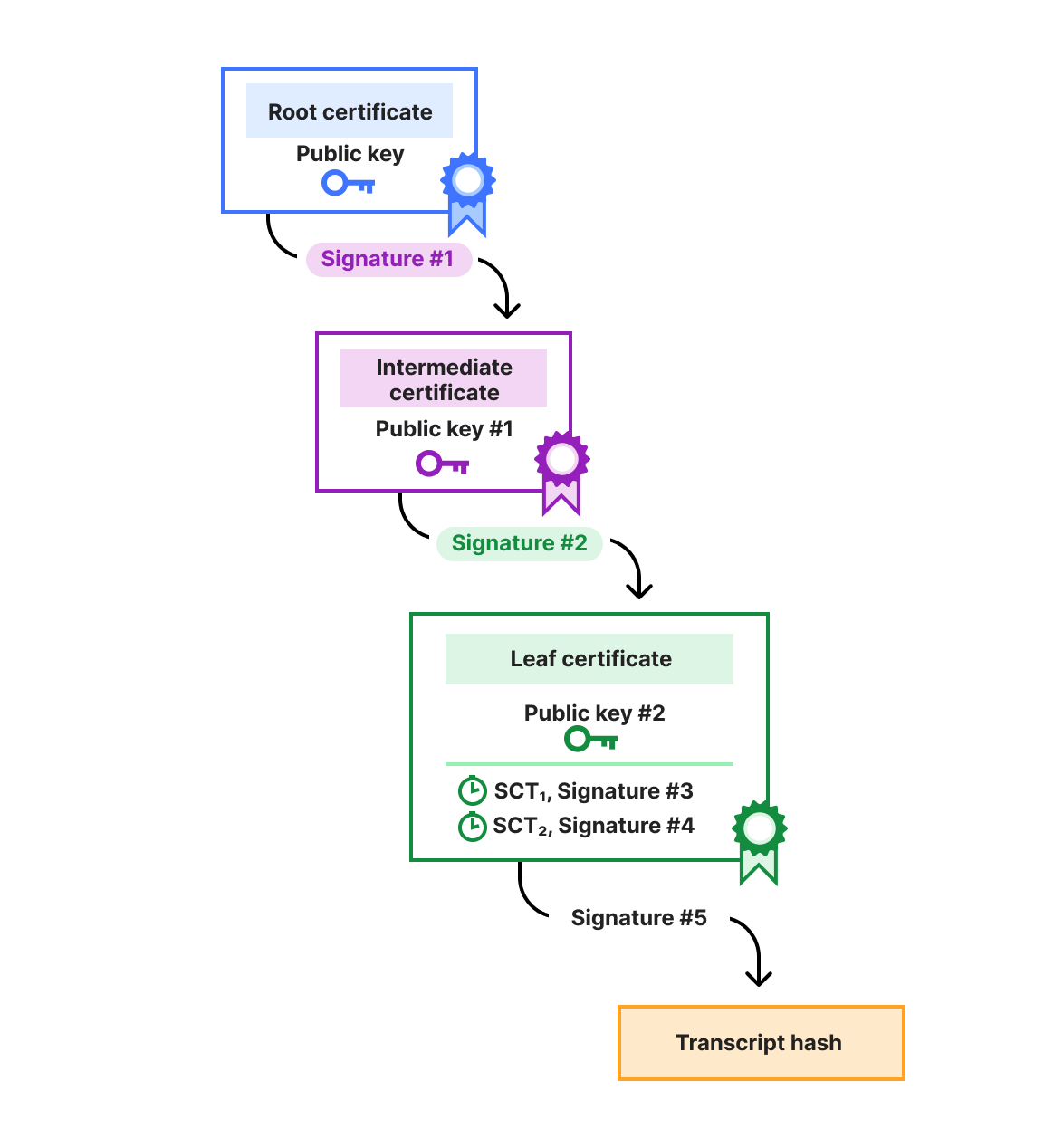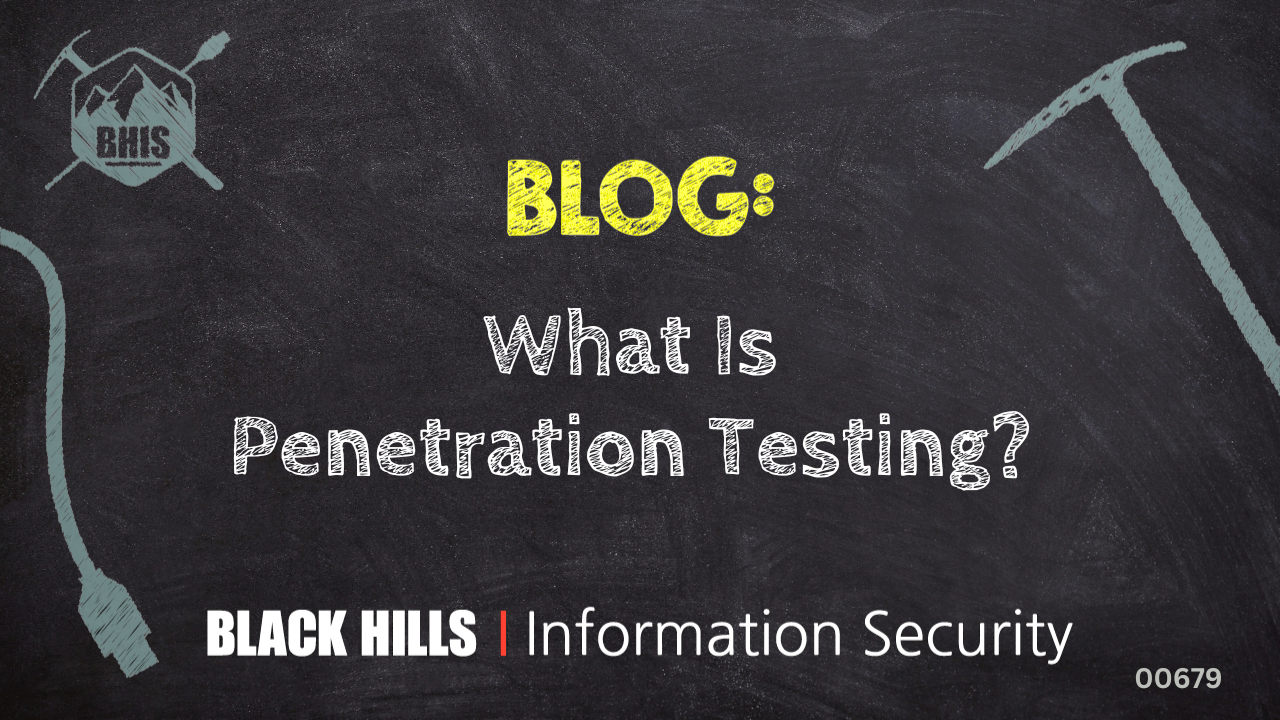Cloudflare’s network spans more than 330 cities in over 125 countries, where we interconnect with over 13,000 network providers in order to provide a broad range of services to millions of customers. The breadth of both our network and our customer base provides us with a unique perspective on Internet resilience, enabling us to observe the impact of Internet disruptions at both a local and national level, as well as at a network level.
As we have noted in the past, this post is intended as a summary overview of observed and confirmed disruptions, and is not an exhaustive or complete list of issues that have occurred during the quarter. A larger list of detected traffic anomalies is available in the Cloudflare Radar Outage Center. Note that both bytes-based and request-based traffic graphs are used within the post to illustrate the impact of the observed disruptions — the choice of metric was generally made based on which better illustrated the impact of the disruption.
In the first quarter of 2025, we observed a significant number of Internet disruptions due to cable damage and power outages. Severe storms caused outages in Ireland and Réunion, and an earthquake caused ongoing connectivity issues in Myanmar. Russian networks were taken offline by a reported cyberattack and purported technical problems, while a fire took a telecom provider in Haiti offline briefly. In Q4 2024, we observed only a single government-directed Internet shutdown, and this quarter, no such shutdowns were observed. Unfortunately, this is an unusual occurrence, and in the three-year history of this blog post series, has only occurred previously in Q4 2023 and Q1 2022.
Just after the new year, Internet connectivity in Pakistan was disrupted by a fault in the AAE-1 submarine cable. According to a January 2 alert published on social media by the Pakistan Telecommunications Authority, the cable fault occurred near Qatar, and would likely impact user experience across the country. Because there are seven submarine cables carrying international Internet traffic to/from Pakistan, the loss of AAE-1 did not cause an observable outage. However, the impact of the disruption was visible in the bandwidth and latency graphs for Pakistan. On January 2 and 3, median latency peaked at around 125 ms, up from a pre-disruption median of approximately 80 ms. Concurrent drops in bandwidth were observed, with media download speeds dropping to around 6 Mbps from a pre-disruption media of around 9 Mbps. In an “Important Update” posted to their Instagram account, Pakistan Telecom (PTCL, AS17557) also highlighted the potential for “slow browsing” — the Internet Quality graphs for that network show similarly-timed shifts in median bandwidth and latency.
Pakistan is currently connected to seven submarine cables, with two additional connections on the way in 2026. This connection diversity means that damage to or an issue with one cable will likely have minimal impact on Internet availability within the country, as traffic can be re-routed across other paths.
According to an announcement from the Syrian Ministry of Communications, a widespread Internet outage spanning January 23-24 was caused by sabotage that damaged two fiber optic cables that run along the highway between Damascus and Homs. The graphs below show that both HTTP and DNS request traffic from Syria dropped to near zero between 00:30 and 03:30 local time on January 24 (21:30 on January 23 – 00:30 on January 24 UTC). Traffic began recovering shortly thereafter, and returned to expected levels by 09:00 local time (06:00 UTC). Announced IPv4 address space for the country, almost exclusively from Syria Telecom (AS29256), also saw an approximately 90% drop during this period, which suggests that these fiber cuts caused a significant amount of Syria Telecom’s network to become unreachable during the incident.
Echoing the disruption above, Syria experienced another Internet outage on March 25, again caused by sabotage that damaged fiber optic cables. According to an announcement from the Syrian Ministry of Communications, the damage occurred in the Maaloula and Hasiya regions, resulting in a near complete outage between 03:00 – 13:15 local time (00:00 – 10:15 UTC). Similar to the January outage, the graphs below show a near complete loss of HTTP request traffic and a significant loss of announced IPv4 address space.
Somewhat paradoxically, DNS request volume from Syria was elevated during this outage, in contrast to the behavior observed during the January event. It isn’t clear what drove the additional traffic to Cloudflare’s 1.1.1.1 DNS resolver in this case.
In early February, several Internet providers in Nepal saw services disrupted when Indian provider Bharti Airtel (AS9498) went offline. AS23752 (Nepal Telecom), AS17501 (Worldlink Communications), AS139922 (Dishhome Fibernet), AS45650 (Vianet Communications), and AS38565 (Ncell), who all have Airtel as an upstream provider or peer, saw traffic disrupted between 21:00 – 22:30 local time (15:15 – 16:45 UTC) on February 2.
Published reports disagree on the underlying cause of the Airtel issue, with one source claiming that it was related to an ongoing payment dispute, while another claims that it was due to reported fiber cuts in Airtel’s network.
Show less
Eleven provinces in Angola lost electrical power on January 6 due to an interruption in the North and Center Interconnected System, according to the National Electricity Transmission Network (RNT). The widespread power outage disrupted Internet connectivity across the country, leading to a drop in traffic between 14:45 – 22:00 local time (13:45 – 21:00 UTC). Published reports said that RNT was investigating the cause of the power outage, but no subsequent information was available confirming a specific cause.
Monkey business at the Pandura electrical substation caused an island-wide power outage in Sri Lanka on February 9. More seriously, a monkey coming into contact with a grid transformer caused the power outage, which resulted in a multi-hour disruption to Internet traffic from the country. Traffic initially dropped around 11:30 local time (06:00 UTC), and recovered by around 21:00 local time (15:30 UTC). The graph below for AS18001 (Dialog), a major Sri Lankan network services provider, illustrates the impact on traffic.
On February 25, a massive power outage in Chile reportedly impacted 98.5% of the country. A published report noted that there was an interruption in the power supply from Arica to the Los Lagos region, caused by a disconnection of the 500 kV transmission system in the Norte Chico. The power outage resulted in an immediate and significant drop in Internet traffic, as seen at a country level, as well at a network level, as shown in the graphs below. Traffic initially fell at around 14:15 local time (18:15 UTC) and recovered to expected levels approximately 12 hours later, around 02:00 local time (06:00 UTC). It was reported that as of an hour after traffic had recovered, approximately 94% of customers had power restored.
A ground fault at the 15 de Septiembre electrical substation in El Salvador was reportedly the cause of a power outage that resulted in a multi-hour Internet disruption in Honduras on March 1. The Regional Operator Entity (OER) stated that the failure occurred at 09:22 local time (15:22 UTC), which resulted in traffic from the country dropping by about half. The disruption to Internet connectivity was relatively short-lived, as traffic returned to expected levels approximately two hours later.
According to an X post from @EnergiasMinasCub (the Cuban state agency responsible for promoting the sustainable development of the country’s energy, geological, and mining sectors), at around 20:15 local time on March 14 (00:15 UTC on March 15) “a failure at the Diezmero substation caused a significant loss of generation in the west of #Cuba and with it the failure of the National Electric System, SEN”. This widespread power outage resulted in an immediate drop in request traffic from Cuba. Over the following two days, X posts from @EnergiasMinasCub, @OSDE_UNE (the Cuban Electric Union), and @ETECSA_Cuba (the Cuban Telecommunications Company) kept impacted subscribers apprised of the status of ongoing repairs. Traffic levels returned to expected levels around 20:00 local time on March 16 (00:00 on March 17 UTC), two full days after the incident began.
An explosion and fire at the La Chorrera Thermoelectric Power Plant in Panama caused a massive power outage across the country, starting at 23:40 local time on March 15 (04:40 on March 16 UTC). As expected, traffic dropped immediately, as seen in the HTTP and DNS request graphs below. However, recovery was fairly swift, as the electric system saw 75% recovery by 03:00 local time (08:00 UTC), with full restoration completed at 06:08 local time (11:08 UTC). Traffic volumes began to increase after power was restored.
Storm Éowyn wreaked havoc on Ireland in late January, knocking out power and water, causing property damage, and limiting air and train travel. The storm’s impacts also disrupted Internet connectivity, as we observed traffic from Connacht and Ulster fall by 75% as compared to the previous week at 06:30 local time (06:30 UTC) on January 24. As recovery from the storm progressed over the next several days, Internet traffic gradually recovered as well, with traffic in the two provinces reaching levels near those seen the prior week by mid-day on January 28.

Cyclone Garance made landfall over the French territory of Réunion at ~10:00 local time (06:00 UTC) on February 28. Damage from the storm’s 100+ miles/hour (160+ km/hour) winds caused power outages and infrastructure damage, resulting in disruptions to Internet connectivity. The most significant impacts to traffic were observed in the hours after the storm made landfall, but it took several days before traffic returned to expected levels, reaching that point around 08:00 local time (04:00 UTC) on March 4.
On March 28 at 12:50 local time (06:20 UTC), a magnitude 7.7 earthquake shook Myanmar, resulting in power outages and fuel shortages. Almost immediately, traffic dropped by around 40% at a country level. Regionally, traffic from Nay Pyi Taw dropped 97% as compared to the previous week, Mandalay fell 90%, Ayeyarwady lost 88%, Bago 50%, and Shan State was down 38%.
While recovery efforts stretch into April, regular traffic patterns and volumes bounced back within days, as seen in the HTTP and DNS request graphs below.
However, at a network level, recovery has been mixed. Both AS134840 (MCCL) and AS136442 (Oceanwave) saw significant drops in traffic after the earthquake occurred, and traffic remained disrupted on both networks through the end of the first quarter. Peak traffic on MCCL has increased slightly, but nearly two weeks on, remains significantly lower than pre-earthquake levels. Traffic on Oceanwave saw steady growth after the initial disruption, and as of this writing is approaching pre-earthquake peaks. (It is unclear what caused the significant spike in request traffic seen from Oceanwave on April 3-4.) In contrast to these two providers, traffic from AS163255 (Mytel) saw a significantly smaller disruption, and a significantly faster recovery, as did traffic from AS135300 (Myanmar Broadband Telecom).
On January 7, Russian Internet provider Nodex (AS29329) said in a post on Russian social media platform VKontakte (translated) “Dear Subscribers, our technical staff is still working on restoring the network. The process is painstaking and long. We express our deep gratitude to those who support us in this difficult moment! This is really important for us. Let me remind you that our network was attacked by Ukrainian hackers, which resulted in its complete failure. At the moment, its functioning is being restored. There will be communication. When, is still unknown.” The Ukrainian Cyber Alliance, a community of pro-Ukraine cyber activists formed in 2016, claimed responsibility for the attack in a Telegram post.
The “complete failure” of the Nodex network is visible in the traffic graph below, where Internet traffic from the network began to drop after 03:00 local time (00:00 UTC) on January 7, reaching zero around 05:30 local time (02:30 UTC). Traffic from the network remained essentially non-existent until around 14:00 local time (11:00 UTC) the next day, recovering fairly quickly after that. Announced IPv4 address space fell by two-thirds at the same time that traffic volume dropped to zero, but recovered at 21:20 local time (18:20 UTC).
Between January 7-9, during the early days of the 2025 Southern California wildfires — which affected the Palisades and Eaton areas in Los Angeles — there were clear Internet disruptions in at least 13 Los Angeles neighborhoods. According to Cloudflare’s data, traffic drops of over 50% compared to the previous week were especially noticeable in cities like Pacific Palisades, Altadena, Malibu, Temple City, and Monrovia, among others. In the weeks that followed, traffic remained significantly lower than before the fires, particularly in Pacific Palisades and Altadena, reflecting the devastation in those areas. However, traffic recovery occurred significantly sooner in Malibu, Temple City, and Monrovia, although peak traffic levels remain somewhat below pre-fire levels.





On January 15, an X post from the Director General of Digicel Haiti (AS27653) stated (translated) “Dear customers, last night at 8:30 pm we suffered damage to 2 of our international fiber optic cables caused by a fire in the metropolitan area. At 10:30 am a 3rd outage affected all international services, Internet and Moncash. Our teams are mobilized to resolve the problem as quickly as possible.” These fires ultimately caused two complete Internet outages for Digicel Haiti’s customers, as seen in the graphs below.
Both traffic and announced IP address space (IPv4 & IPv6) dropped to zero between 20:30 – 21:45 local time on January 14 (01:30 – 02:45 on January 15 UTC) and again between 10:15 – 11:00 local time on January 15 (15:15 – 16:00 UTC).
On January 14, multiple Russian networks, including AS8359 (MTS), AS12389 (Rostelecom), AS16345 (Beeline), AS31133 (MegaFon), and AS203451 (K-telecom) all experienced a brief disruption in connectivity. As the traffic graphs below show, Internet traffic from these networks dropped by around 80% between 14:00 – 14:30 UTC. According to a statement from Roskomnadzor, “A brief connectivity issue was identified. Network operations were promptly restored.” However, industry observers suggested that the cause may have been due to an update to the so-called “Russian firewall” that failed and was quickly rolled back.
Subscribers to Magticom (AS16010), one of the largest Internet providers in Georgia, experienced a complete outage on January 27. Request traffic and announced IP address space disappeared at 21:25 local time (17:25 UTC), recovering at 01:55 local time on January 28 (21:55 UTC). A (translated) Facebook post from Magticom explained that the company’s Internet connectivity comes through “channels from Europe” and that “damage was reported in Turkey, where heavy snowfall and avalanche risks have prevented the partner company’s technical teams from reaching the affected area”. Further, it noted that on the backup channel, “suspicious damage was reported at three points on the Georgian side, in the territory of Adjara…” Magticom’s published start and end times for the outage align with the loss and recovery of traffic and announced IP address space observed in Cloudflare data.
Subscribers of Bouygues Telecom (AS5410) in France experienced a brief disruption to their Internet connectivity on March 11. According to a (translated) X post from the provider, “Following a technical incident between 5 a.m. and 7 a.m. you may have encountered difficulties using your services.” As seen in the request traffic graphs below, a drop in traffic is visible between 05:00 – 06:45 local time (04:00 – 05:45 UTC), aligning with the provider’s stated timeframe. Bouyges Telecom did not provide any subsequent details around the cause of the “technical incident”.
Major Internet outages and disruptions in Syria are generally well documented, such as the cable cuts discussed above. However, on February 3, a multi-hour disruption was observed in the country, but no underlying cause was ever publicly disclosed. Starting approximately 14:00 local time (11:00 UTC), traffic from the country dropped by approximately 80%, along with a ~60% drop in announced IPv4 address space. Both traffic and announced IP address space returned to expected levels around 23:00 local time (20:00 UTC). The outage was confirmed in an X post from Syrian Television.
While the single government-directed shutdown last quarter, and the lack of such shutdowns this quarter, is an encouraging trend, we expect that it will be short-lived if countries like Iraq and Syria once again take such measures to prevent cheating on nationwide exams. As always, we encourage governments to recognize the collateral damage of such actions, and suggest that they explore alternative solutions to this problem.
The Cloudflare Radar team is constantly monitoring for Internet disruptions, sharing our observations on the Cloudflare Radar Outage Center, via social media, and in posts on blog.cloudflare.com. Follow us on social media at @CloudflareRadar (X), noc.social/@cloudflareradar (Mastodon), and radar.cloudflare.com (Bluesky), or contact us via email.



